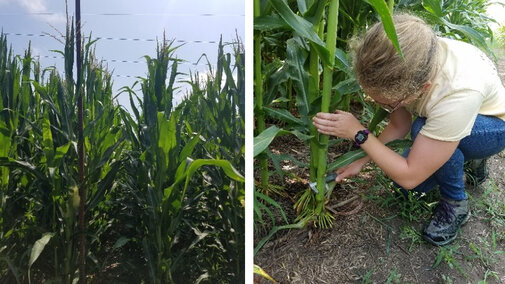Cover crops provide several economic and environmental benefits; however, there are also some potential challenges to consider when planting a cover crop. Specifically, cover crop species and planting date are two factors that could affect the following crop. Field studies of corn following two species of cover crops and three planting dates were compared to see if either species or planting date of the cover crop reduced corn growth and development. Rye, oat, a rye-oat mix, and a control (no cover crop) were planted after wheat before corn, in a rain-fed field. Cover crops were planted on August 14, September 6, and October 25. The development and height of the subsequent corn crop were impacted by a rye or rye-oat mix cover crop, while the oat cover crop and control did not have an impact. Soil moisture and nitrogen levels most likely caused the changes in corn height and development.
Benefits and Potential Challenges of Cover Crops in a Wheat-Corn Rotation
In a wheat-corn rotation there is a long time when there is no crop growing in the field. Long-term exposed soil is vulnerable to soil erosion, nitrogen leaching, and other types of soil degradation. Planting a cover crop following wheat in early fall provides protection from soil erosion over winter and in early spring, and immobilizes the nitrogen to prevent nitrogen leaching (Martinez-Feria, et al., 2016). Planting a rye or oat cover crop to be harvested for forage or grazed during the winter could help to alleviate some of the costs of planting a cover crop.
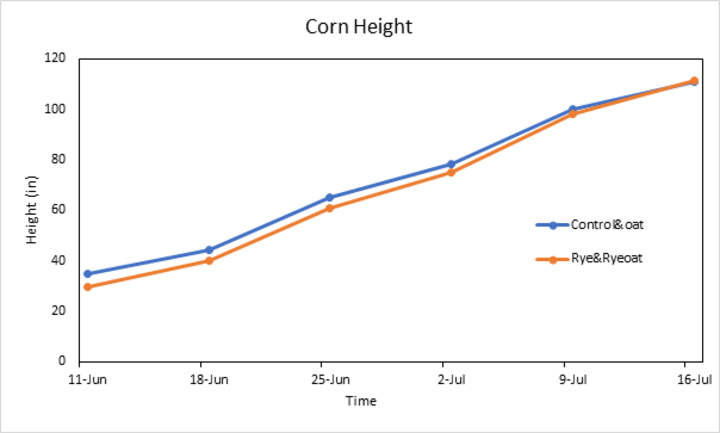
While there are many benefits, there are some potential challenges to planting a cover crop. Cover crops may tie up soil nitrogen, making less available to the following crop, or take up water from the soil, reducing soil moisture for the following crop. Rye grows through the winter and takes up more soil moisture and nutrients than oats, which are winter killed; however, because rye grows through the winter, it creates more biomass for forage and ground cover.
Impact of Cover Crops on Corn Growth
The field trial was conducted near Clay Center on rainfed fields. Corn height and diameter were measured weekly from June 16 through July 27 (Figure 1). Corn height was impacted by the rye and rye-oat mix cover crop. Corn after an oat cover crop was taller than corn after a rye or rye-oat mix through July 2 (Figure 2). However, all corn height became similar by early July.
Corn was planted one day after cover crops were terminated. Rye would have still been growing and could have caused competition with the corn seedlings early in the season, reducing height early in the growing season. Corn diameter was not affected by the presence of a cover crop. There was a minor reduction in corn diameter due to a rye cover crop, but no significant differences were found.
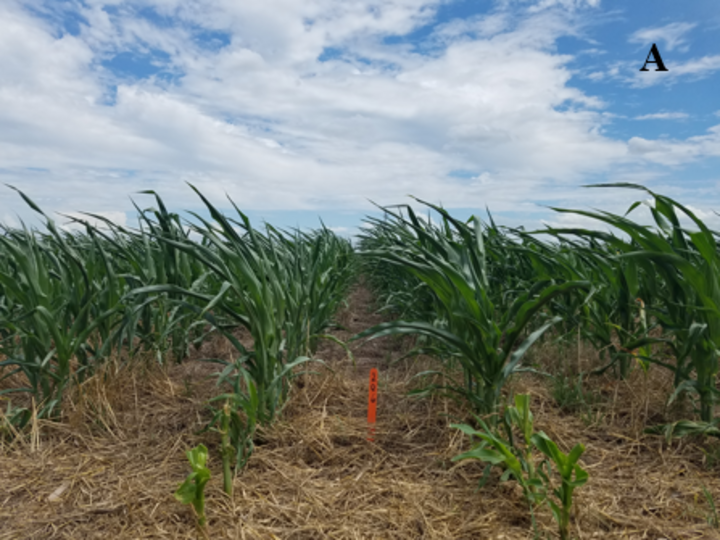
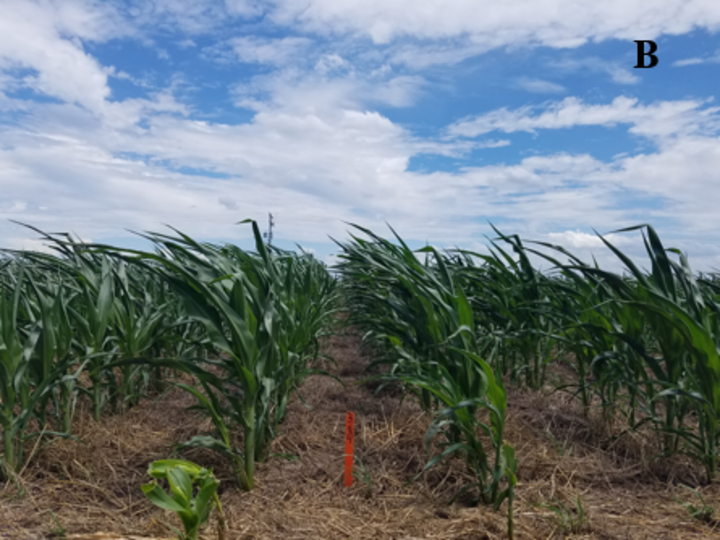
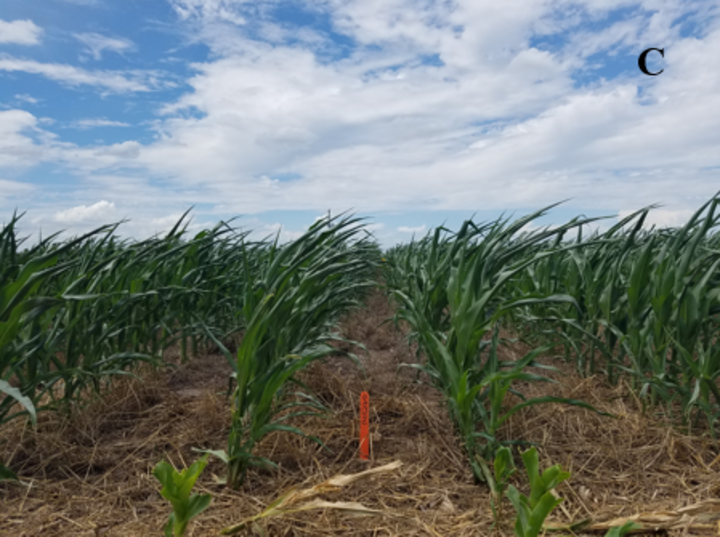
Figure 3. Corn height on June 18 after control (A), oats (B), and rye (C).
Impact of Cover Crops on Corn Development
Corn after a rye or rye-oat mix cover crop was slower to develop compared to corn after an oat cover crop. Development was most similar early in the season; however, corn after a rye cover crop fell further behind in development later in the season compared to corn after an oat cover crop (Figure 4). This trend continued into the reproductive stages. Corn planted after a rye or rye-oat cover crop was less developed than the corn plated after an oat cover crop or no cover crop (Figure 5).
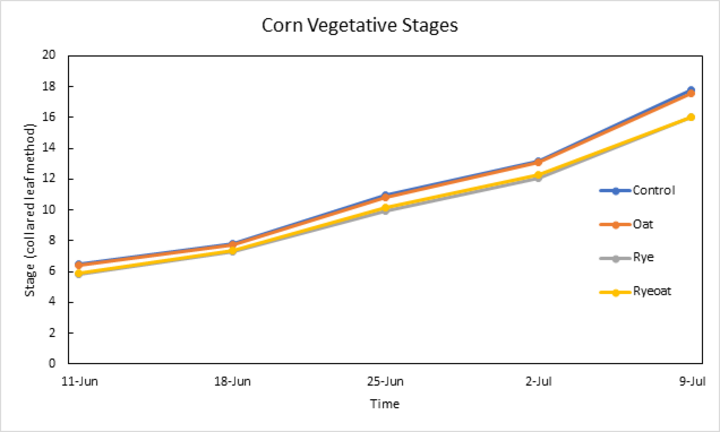

The 2018 growing season experienced relatively high precipitation. A wetter season may have dampened some of the rye cover crop’s effect on corn growth and development. Rye may decrease soil moisture levels and having more rain during the growing season would restore soil moisture levels faster, causing the rye cover crop to have less of an effect on corn growth and development.
Conclusions
- Killing a cover crop at the proper time may reduce developmental effects on the subsequent corn crop. Killing a cover crop at least 10 days before planting corn will help to reduce developmental effects of the cover crop (Acharya et al., 2017). If the cover crop is completely killed at corn planting, competition from the cover crop will be reduced.
- Delays in development may not affect corn yields. While there were delays in corn development after a rye cover crop, in the past two years of this study, no yield effects were found. Delays in development may not cause decreases in yield compared to the control. (See related CropWatch stories: Rain-Fed Corn Growth and Development Following Cover Crops in 2017 and Student Research: What are the remnant effects of rye and oat cover crops on corn development?
- Soil health benefits of cover crops outweigh the challenges. Cover crops provide many invaluable soil health benefits (Blanco-Canqui et al., 2015). These benefits include reduced soil erosion, reduction in soil temperature due to biomass, and protection of surrounding bodies of water from nitrogen leaching.
References
Abendroth, L. J., Elmore, R. W., Boyer, M. J., and Marlay, S. K. (2011). Corn Growth and Development. Ames, Iowa: Iowa State University.
Acharya, J., Bakker, M. G., Moorman, T. B., Kaspar, T. C., Lenssen, A. W., and Robertson, A. E. (2017). Time Interval Between Cover Crop Termination and Planting Influences Corn Seedling Disease, Plant Growth, and Yield. Plant Disease, 101(4), 591-600. doi:10.1094/pdis-07-16-0975-re
Blanco-Canqui, H., Shaver, T. M., Lindquist, J. L., Shapiro, C. A., Elmore, R. W., Francis, C. A., and Hergert, G. W. (2015). Cover Crops and Ecosystem Services: Insights from Studies in Temperate Soils. Agronomy Journal, 107(6), 2449-2474. doi:10.2134/agronj15.0086
Martinez-Feria, R. A., Dietzel, R., Liebman, M., Helmers, M. J., and Archontoulis, S. V. (2016). Rye cover crop effects on maize: A system-level analysis. Field Crops Research, 196, 145-159. doi:10.1016/j.fcr.2016.06.016
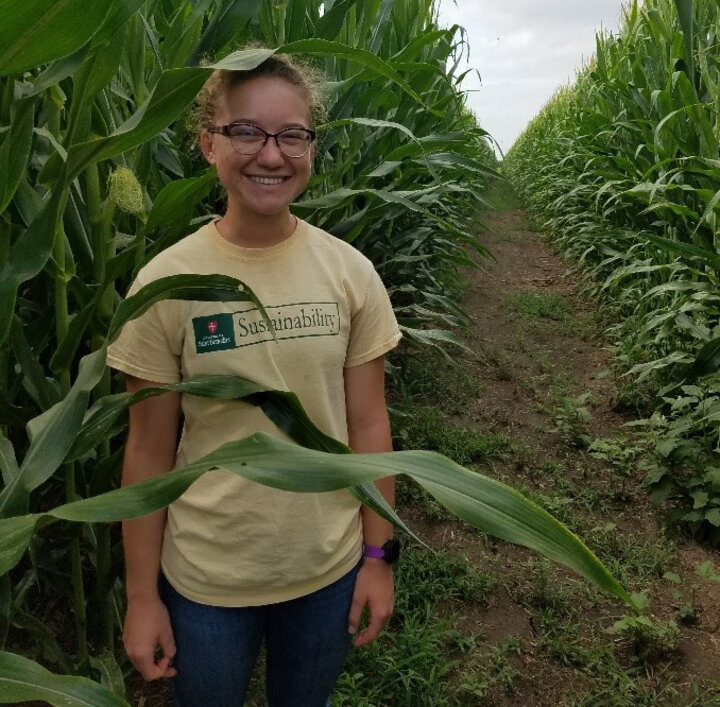
About the Author
Abigail Borgmeier was one of nine undergraduate students completing an Integrated Agronomic Systems Fellowship at the University of Nebraska-Lincoln in summer 2018.
She is a senior biology major at the College of Saint Benedict in St. Cloud, Minn. After graduation, she hopes to attend graduate school to study plant pathology.
Support
This project was made possible by the USDA NIFA Agriculture and Food Research Initiative: Education and Literacy Initiative–Undergraduate Experiential Learning Fellowship Program and by the University of Nebraska-Lincoln Department of Agronomy.
